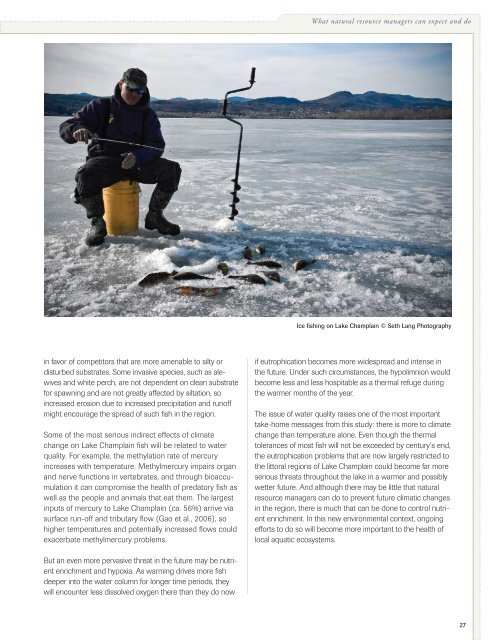<strong>Climate</strong> <strong>Change</strong> <strong>in</strong> <strong>the</strong> Champla<strong>in</strong> Bas<strong>in</strong>tions to o<strong>the</strong>r water bodies have led to a mix of boreal fishes(whitefish, nor<strong>the</strong>rn pike, lake trout), Atlantic coastal species(ra<strong>in</strong>bow smelt, American eel, Atlantic salmon, sea lamprey,fallfish, cutlips m<strong>in</strong>now, cha<strong>in</strong> pickerel, tessellated darter), andMississippi watershed species (gar, sturgeon, bowf<strong>in</strong>). At lastcount, 15 k<strong>in</strong>ds of nonnative fish are also present.One reason why Lake Champla<strong>in</strong> supports such biodiversityis its great size and depth, which affords a wide range ofhabitats for both cold-water and warm-water fish. Lake-connectedwetlands also provide spawn<strong>in</strong>g grounds for nor<strong>the</strong>rnpike, yellow perch, brown bullhead, bowf<strong>in</strong>, largemouth bass,black crappie, carp, mudm<strong>in</strong>now and longnose gar. Regardlessof <strong>the</strong> emissions scenario or model projection underconsideration, large deep lakes such as Champla<strong>in</strong> shouldcont<strong>in</strong>ue to support a diversity of aquatic environments dur<strong>in</strong>g<strong>the</strong> rest of this century, <strong>in</strong>clud<strong>in</strong>g cold-water fish habitat,though <strong>the</strong> quality and extent of that habitat may be reduced(Stefan et al., 2001).A fish’s body temperature is about equal to <strong>the</strong> temperatureof <strong>the</strong> water <strong>in</strong> which it lives. Still, future warm<strong>in</strong>g is less likelyto threaten most fish directly than to alter <strong>the</strong>ir habitat, foodsources and distribution. For example, climate-driven changes<strong>in</strong> <strong>the</strong> availability and composition of zooplankton could causemajor changes <strong>in</strong> <strong>the</strong> lake’s food web, particularly amongpost-larval fish that have absorbed <strong>the</strong>ir egg sac and whosesurvival depends on preferred prey be<strong>in</strong>g immediately available(R. Langdon, personal communication). In addition, <strong>the</strong>fraction of Lake Champla<strong>in</strong> that is classified as warm-waterhabitat is likely to expand, and higher water temperaturesmight make it easier for some heat-tolerant alien species to<strong>in</strong>vade. Because <strong>the</strong> potential <strong>in</strong>teractions between ecosystemsand human behavior are too complex to let us predictwith certa<strong>in</strong>ty how any given species will be affected byclimatic changes or alien <strong>in</strong>troductions, <strong>the</strong> most effectiveapproach to address<strong>in</strong>g those risks will <strong>in</strong>volve <strong>the</strong> careful,cont<strong>in</strong>uous monitor<strong>in</strong>g and management of both game andnongame species.Different organisms will respond physiologically to futurewarm<strong>in</strong>g <strong>in</strong> <strong>the</strong> Champla<strong>in</strong> Bas<strong>in</strong> <strong>in</strong> different ways. Rates offood consumption, metabolism and growth for some fish speciesare likely to <strong>in</strong>crease if warm<strong>in</strong>g pushes <strong>the</strong>rmal conditionscloser to <strong>the</strong>ir preferred temperature ranges (Shuteret al., 2003); smallmouth bass and walleye <strong>in</strong> <strong>the</strong> ColumbiaRiver, for example, have been projected to <strong>in</strong>crease <strong>the</strong>irconsumption of salmonids 4–6 % for every 1°C (1.8°F) <strong>in</strong>crease<strong>in</strong> water temperature (Rahel and Olden, 2008). On <strong>the</strong>o<strong>the</strong>r hand, cold-water species such as burbot can becomelethargic and fail to feed at higher temperatures (Jackson etal., 2008). As <strong>the</strong>rmal habitats and biological communitieswith<strong>in</strong> Lake Champla<strong>in</strong> are restructured, fish may also beforced to <strong>in</strong>teract with new competitors, food sources andparasites with<strong>in</strong> <strong>the</strong>ir home lake, a situation not unlike hav<strong>in</strong>gto compete with <strong>in</strong>troduced species (Ficke et al., 2007).Shifts <strong>in</strong> <strong>the</strong> magnitudes and/or tim<strong>in</strong>g of peak snowmeltdrivenstream flows <strong>in</strong> w<strong>in</strong>ter and spr<strong>in</strong>g might affect <strong>the</strong> reproductivecycles of stream-dependent species, because egghatch<strong>in</strong>g is often timed <strong>in</strong> ways that allow young fish to f<strong>in</strong>drefuge from strong early-season flows. Most stream-spawners<strong>in</strong> <strong>the</strong> Champla<strong>in</strong> Bas<strong>in</strong> spawn <strong>in</strong> spr<strong>in</strong>g, so earlier meltwaterpeaks could be potentially disruptive if fish fail to adjust<strong>the</strong>ir behavior accord<strong>in</strong>gly. Projected <strong>in</strong>creases <strong>in</strong> w<strong>in</strong>ter ra<strong>in</strong>(as opposed to snowfall) could also generate more frequentcold-season floods and ice flows that can scour streambedsand kill eggs, larvae and adult fish (Frumhoff et al., 2007);this might be especially problematic for burbot, which maymove <strong>in</strong>to rivers to spawn <strong>in</strong> w<strong>in</strong>ter. Atlantic salmon spawn<strong>in</strong> autumn, so <strong>the</strong>y might <strong>in</strong>stead face problems from warmerand slower stream flows.Swollen rivers tend to become more erosive and carry moresediment downstream, and <strong>the</strong> heavy silt loads associatedwith this can <strong>in</strong>filtrate <strong>the</strong> gills of fish, bury benthic habitatsand <strong>in</strong>vertebrates, and suffocate eggs as well as larval fishand <strong>in</strong>vertebrates (Brennan and Culverwell, 2004). Undersuch conditions, species such as darters and sculp<strong>in</strong> that liveor spawn on rocky or sandy substrates may be suppressedSouth Bay, Lake Champla<strong>in</strong> © Bob Kle<strong>in</strong> Ice jam, Otter Creek, VT, courtesy of VT DEC Willoughby Falls © Bob Kle<strong>in</strong>26
What natural resource managers can expect and doIce fish<strong>in</strong>g on Lake Champla<strong>in</strong> © Seth Lang Photography<strong>in</strong> favor of competitors that are more amenable to silty ordisturbed substrates. Some <strong>in</strong>vasive species, such as alewivesand white perch, are not dependent on clean substratefor spawn<strong>in</strong>g and are not greatly affected by siltation, so<strong>in</strong>creased erosion due to <strong>in</strong>creased precipitation and runoffmight encourage <strong>the</strong> spread of such fish <strong>in</strong> <strong>the</strong> region.Some of <strong>the</strong> most serious <strong>in</strong>direct effects of climatechange on Lake Champla<strong>in</strong> fish will be related to waterquality. For example, <strong>the</strong> methylation rate of mercury<strong>in</strong>creases with temperature. Methylmercury impairs organand nerve functions <strong>in</strong> vertebrates, and through bioaccumulationit can compromise <strong>the</strong> health of predatory fish aswell as <strong>the</strong> people and animals that eat <strong>the</strong>m. <strong>The</strong> largest<strong>in</strong>puts of mercury to Lake Champla<strong>in</strong> (ca. 56%) arrive viasurface run-off and tributary flow (Gao et al., 2006), sohigher temperatures and potentially <strong>in</strong>creased flows couldexacerbate methylmercury problems.if eutrophication becomes more widespread and <strong>in</strong>tense <strong>in</strong><strong>the</strong> future. Under such circumstances, <strong>the</strong> hypolimnion wouldbecome less and less hospitable as a <strong>the</strong>rmal refuge dur<strong>in</strong>g<strong>the</strong> warmer months of <strong>the</strong> year.<strong>The</strong> issue of water quality raises one of <strong>the</strong> most importanttake-home messages from this study: <strong>the</strong>re is more to climatechange than temperature alone. Even though <strong>the</strong> <strong>the</strong>rmaltolerances of most fish will not be exceeded by century’s end,<strong>the</strong> eutrophication problems that are now largely restricted to<strong>the</strong> littoral regions of Lake Champla<strong>in</strong> could become far moreserious threats throughout <strong>the</strong> lake <strong>in</strong> a warmer and possiblywetter future. And although <strong>the</strong>re may be little that naturalresource managers can do to prevent future climatic changes<strong>in</strong> <strong>the</strong> region, <strong>the</strong>re is much that can be done to control nutrientenrichment. In this new environmental context, ongo<strong>in</strong>gefforts to do so will become more important to <strong>the</strong> health oflocal aquatic ecosystems.But an even more pervasive threat <strong>in</strong> <strong>the</strong> future may be nutrientenrichment and hypoxia. As warm<strong>in</strong>g drives more fishdeeper <strong>in</strong>to <strong>the</strong> water column for longer time periods, <strong>the</strong>ywill encounter less dissolved oxygen <strong>the</strong>re than <strong>the</strong>y do now27
















